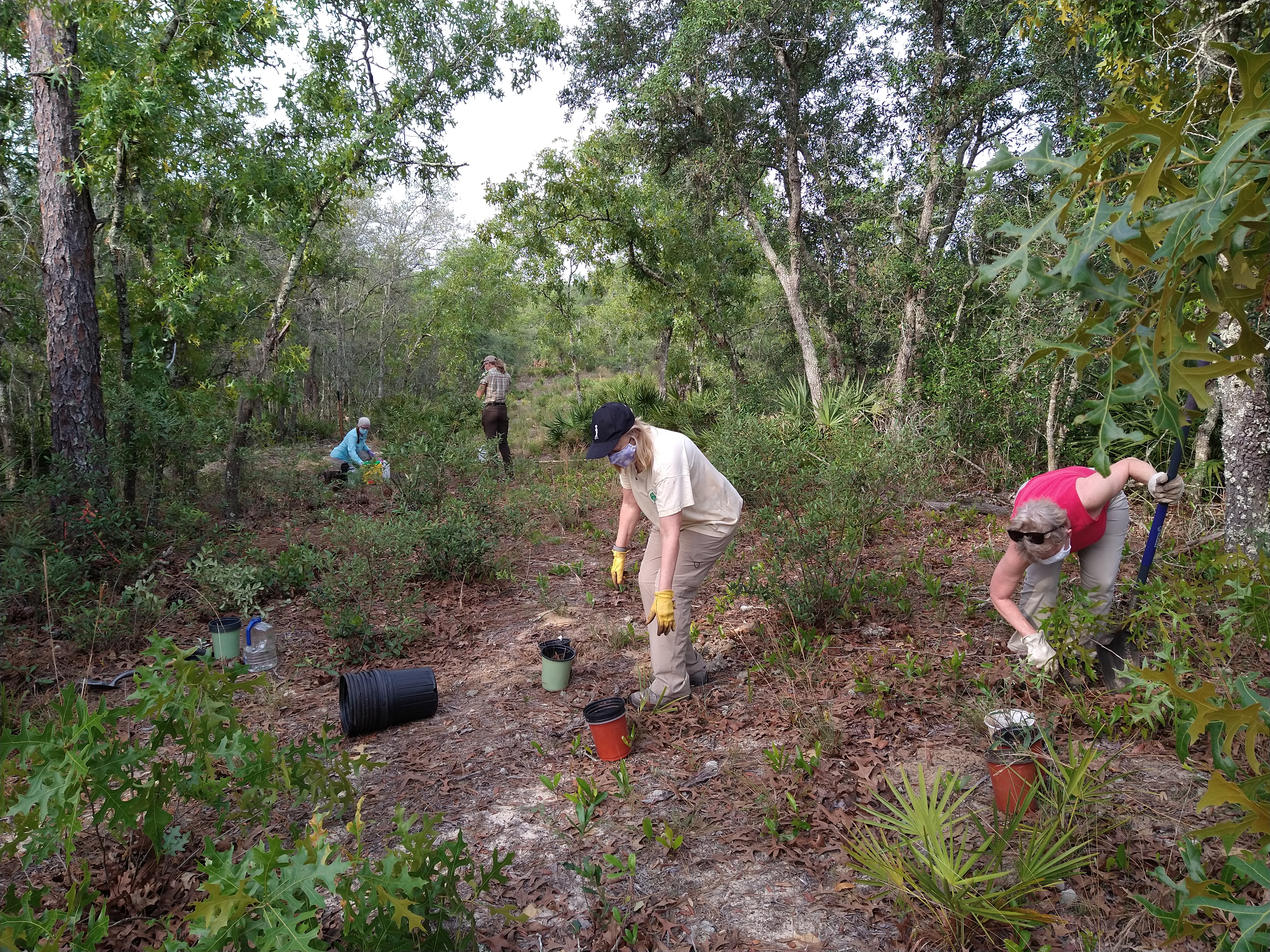
By Katrina Stephenson
Earlier this year, Lake County employee, Veronica Dau, reached out to Passionflower Chapter asking us to collaborate on several projects in conjunction with Keep Lake Beautiful and America in Bloom (AIB).
County officials and members of AIB wanted to learn more about FNPS, our mission, and Florida native plants for projects in public spaces throughout the county. They were also interested in installing roadside “pollinator pathways” as other cities have done. Melanie Simon of the Passionflower Chapter and Neta Villalobos-Bell from the Lake Beautyberry Chapter presented to a round table of elected officials and county employees in April 2021 about the benefit of planting Florida native plants.
Ms. Dau quickly identified Cagan Crossings Community Library in the Four Corners area of Lake County as a site that was interested in refurbishing their pollinator garden and reached out to the Passionflower Chapter to see if we could help.
The library already had a pollinator garden that had been thoughtfully installed by a local scout troop, but unfortunately, the only plants in the space included invasive Mexican petunia, non-native tropical milkweed, and fountaingrass.
Fortunately, the site did have an (inactive) gopher tortoise burrow, a small self-seeded wild cherry tree, a fully functioning rain bird irrigation system as well as a hose hook-up, some stone benches and stepping stones, and a great combination of all-day sun and deep shade. There was real potential for creating a diverse wildlife habitat.
The first step was to rip out all that Mexican petunia and other non-native invasives. On August 29th, volunteers ripped out an entire truckload of invasive species, most of which had rooted themselves to landscape fabric that was hiding under the thick layer of pine bark. We did away with all of that as well (or at least as much as we physically could!).
We had also reached out to all Passionflower members asking for donations of plants. Keep Lake Beautiful donated funds to the project and Friends of Cagan Crossings started a fundraiser and advertised it to library visitors. With the money raised, we were able to purchase three trellises, a stone bird bath, additional stepping stones, and some more established native nursery plants from Green Isle Gardens.
Amazingly, Passionflower members donated nearly 75 plants, most of which were volunteers from their yards. Native plants from a rescue site were also donated to the project.
All in all, by September we collected over 130 plants and over 30 different native species to install on the site, which was roughly 30’ by 20’. A complete plant list has been included as an addition to this article.
The project was definitely getting noticed and gaining traction in the local community. When we showed up on September 16th to install the garden, we were greeted by over 20 eager volunteers who had heard about the project from Keep Lake Beautiful, Friends of Cagan Crossings and Give a Day Foundation.
Working off of a rough design sketch, Passionflower members placed the plants in the site starting with the shrubs and grasses, and then the smaller plants and wildflowers. Volunteers were given specific instructions on how to plant each plant and got busy digging. They also moved hardscaping, mulch, and logs into the space.
Since many of the volunteers required direction and did not possess gardening or botanical knowledge, it was very important that FNPS members with experience circled around to answer questions, help give instructions, make quick decisions, and provide patient and friendly education when needed. If any other chapters attempt a project like this, we strongly advise having several knowledgeable “forepeople” overseeing the project so that your volunteers are not sitting idly. They may not possess knowledge of native plants and habitat restoration, but they want to do good and are eager to help!
The result: In less than three hours, all plants were in the ground and an incredibly biodiverse wildlife habitat full of colors, layers, and textures now sits in a public space at the Cagan Crossings Community Library. Visitors can enjoy sitting outside in the space or viewing it from inside through the large windows.
Passionflower unveiled the space formally on October 14th to celebrate Florida Native Plant Month. Friends of Cagan Crossings has expressed an interest in forming a garden club and have asked our members for guidance and garden maintenance instructions.
Since this site is at a library, we thought it only appropriate to recommend a list of books and brochures to display so that visitors can learn more about Florida native plants, pollinators, and wildlife, as well. The library staff and volunteers are truly dedicated to educating the public about the benefits of native plants and they are thrilled to now host a demonstration garden in a public space for all to see.
We at Passionflower were very humbled and grateful that Keep Lake Beautiful, Friends of Cagan Crossings, and all the other volunteers involved in this project were fully committed to Passionflowers’s vision for the site and trusted our expertise. We consider ourselves fortunate to have had the opportunity to work with a group of dedicated people who - no matter what their background, experience, or knowledge of gardening or native plants - all united around the common goal of doing what is best for our local plant, insect, and animal wildlife.
If you would like to know more about the Cagan Crossings Garden or have any questions, please reach out to us at passionflower.fnps@gmail.com.







